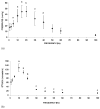Dynamic skeletal muscle stimulation and its potential in bone adaptation
- PMID: 20190376
- PMCID: PMC4961074
Dynamic skeletal muscle stimulation and its potential in bone adaptation
Abstract
To identify mechanotransductive signals for combating musculoskeletal deterioration, it is essential to determine the components and mechanisms critical to the anabolic processes of musculoskeletal tissues. It is hypothesized that the interaction between bone and muscle may depend on fluid exchange in these tissues by mechanical loading. It has been shown that intramedullary pressure (ImP) and low-level bone strain induced by muscle stimulation (MS) has the potential to mitigate bone loss induced by disuse osteopenia. Optimized MS signals, i.e., low-intensity and high frequency, may be critical in maintaining bone mass and mitigating muscle atrophy. The objectives for this review are to discuss the potential for MS to induce ImP and strains on bone, to regulate bone adaptation, and to identify optimized stimulation frequency in the loading regimen. The potential for MS to regulate blood and fluid flow will also be discussed. The results suggest that oscillatory MS regulates fluid dynamics with minimal mechanical strain in bone. The response was shown to be dependent on loading frequency, serving as a critical mediator in mitigating bone loss. A specific regimen of dynamic MS may be optimized in vivo to attenuate disuse osteopenia and serve as a biomechanical intervention in the clinical setting.
Conflict of interest statement
The authors have no conflict of interest.
Figures





Similar articles
-
Intramedullary pressure and matrix strain induced by oscillatory skeletal muscle stimulation and its potential in adaptation.J Biomech. 2009 Jan 19;42(2):140-5. doi: 10.1016/j.jbiomech.2008.10.018. Epub 2008 Dec 9. J Biomech. 2009. PMID: 19081096 Free PMC article.
-
Dynamic hydraulic fluid stimulation regulated intramedullary pressure.Bone. 2013 Nov;57(1):137-41. doi: 10.1016/j.bone.2013.07.030. Epub 2013 Jul 27. Bone. 2013. PMID: 23895997 Free PMC article.
-
The effect of muscle dysfunction on bone mass and morphology.J Musculoskelet Neuronal Interact. 2010 Mar;10(1):25-34. J Musculoskelet Neuronal Interact. 2010. PMID: 20190377 Review.
-
Low amplitude, high frequency strains imposed by electrically stimulated skeletal muscle retards the development of osteopenia in the tibiae of hindlimb suspended rats.Med Eng Phys. 2005 May;27(4):285-93. doi: 10.1016/j.medengphy.2004.12.014. Med Eng Phys. 2005. PMID: 15823469
-
Is bone formation induced by high-frequency mechanical signals modulated by muscle activity?J Musculoskelet Neuronal Interact. 2010 Mar;10(1):3-11. J Musculoskelet Neuronal Interact. 2010. PMID: 20190375 Free PMC article. Review.
Cited by
-
The skeletal muscle secretome: an emerging player in muscle-bone crosstalk.Bonekey Rep. 2012 Apr 11;1:60. doi: 10.1038/bonekey.2012.60. eCollection 2012. Bonekey Rep. 2012. PMID: 23951457 Free PMC article.
-
Experimental proof that multivariate patterns among muscle attachments (entheses) can reflect repetitive muscle use.Sci Rep. 2019 Nov 12;9(1):16577. doi: 10.1038/s41598-019-53021-8. Sci Rep. 2019. PMID: 31719626 Free PMC article.
-
Determinants of muscle power and force as assessed by Jumping Mechanography in rural Indian children.J Musculoskelet Neuronal Interact. 2022 Mar 1;22(1):43-51. J Musculoskelet Neuronal Interact. 2022. PMID: 35234158 Free PMC article.
-
Effects of whole body vibration on bone properties in growing rats.Int Biomech. 2022 Dec;9(1):19-26. doi: 10.1080/23335432.2022.2142666. Int Biomech. 2022. PMID: 36384427 Free PMC article.
-
Low-Frequency Electrical Stimulation of Denervated Skeletal Muscle Retards Muscle and Trabecular Bone Loss in Aged Rats.Int J Med Sci. 2019 Jun 2;16(6):822-830. doi: 10.7150/ijms.32590. eCollection 2019. Int J Med Sci. 2019. PMID: 31337955 Free PMC article.
References
-
- Akima H, Katayama K, Sato K, Ishida K, Masuda K, Takada H, Watanabe Y, Iwase S. Intensive cycle training with artificial gravity maintains muscle size during bed rest. Aviat Space Environ Med. 2005;76:923–9. - PubMed
-
- Akima H, Kawakami Y, Kubo K, Sekiguchi C, Ohshima H, Miyamoto A, Fukunaga T. Effect of short-duration spaceflight on thigh and leg muscle volume. Med Sci Sports Exerc. 2000;32:1743–7. - PubMed
-
- Allen MR, Hogan HA, Bloomfield SA. Differential bone and muscle recovery following hindlimb unloading in skeletally mature male rats. J Musculoskelet Neuronal Interact. 2006;6:217–25. - PubMed
-
- BeDell KK, Scremin AM, Perell KL, Kunkel CF. Effects of functional electrical stimulation-induced lower extremity cycling on bone density of spinal cord-injured patients. Am J Phys Med Rehabil. 1996;75:29–34. - PubMed
-
- Belanger M, Stein RB, Wheeler GD, Gordon T, Leduc B. Electrical stimulation: can it increase muscle strength and reverse osteopenia in spinal cord injured individuals? Arch Phys Med Rehabil. 2000;81:1090–8. - PubMed
